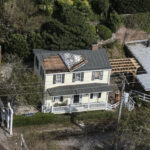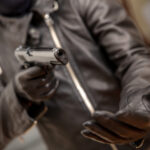A plastic label on a single loose wire that blocked the wire from being fully connected caused an electrical blackout that led to the fatal collision of the 984-foot-long containership Dali into Baltimore’s Francis Scott Key Bridge in 2024.
Investigators from the National Transportation Safety Board (NTSB) yesterday reported that the loose wire in the ship’s electrical system caused a breaker to unexpectedly open. That in turn triggered a sequence of events that led to two vessel blackouts and a loss of both propulsion and steering near the 2.37-mile-long Key Bridge on March 26, 2024.
The investigators found that wire-label banding prevented the wire from being fully inserted into a terminal block spring-clamp gate, causing an inadequate connection.
The collision killed six workers and disrupted one of the nation’s busiest ports.

In announcing the findings, NTSB Chairwoman Jennifer Homendy remarked on the likelihood of finding the cause.
“Our investigators routinely accomplish the impossible, and this investigation is no different,” commented Homendy. “The Dali, at almost 1,000 feet, is as long as the Eiffel Tower is high, with miles of wiring and thousands of electrical connections. Finding this single wire was like hunting for a loose rivet on the Eiffel Tower.”
The owners of the cargo ship Dali identified issues with the electrical switchboard in their negligence lawsuit in August against Hyundai Heavy Industries, the company that built the vessel. Grace Ocean Private and Synergy Marine PTE Ltd, claim that the switchboard was defectively designed in a manner that wiring connections were not secure.
According to the NTSB final report’s summary, after the first blackout, the Dali’s began swinging to starboard toward Pier 17 of the Key Bridge. The pilots and the bridge team attempted to change the vessel’s trajectory, but their actions were ineffective due to the loss of propulsion so close to the bridge.
A substantial portion of the bridge subsequently collapsed into the river, and portions of the pier, deck and truss spans collapsed onto the vessel’s bow and most container bays. A seven-person road maintenance crew and one inspector were on the bridge when the vessel struck. Six of the highway workers died.
Overall, the NTSB found that the quick actions of the Dali pilots, shoreside dispatchers and the Maryland Transportation Authority (MDTA) police to stop bridge traffic prevented greater loss of life. MDTA police officers, who were stationed on both ends of the bridge conducting traffic control, immediately stopped all traffic from entering onto the bridge, and as a result, the bridge was cleared of traffic about 48 seconds before the vessel struck the bridge.
However, the report indicates that the six lives lost may have been saved if not for a communications lapse. The seven highway workers and inspector on bridge at the time were not notified of the Dali’s emergency situation before the bridge collapsed. Had they been called about the same time the MDTA police officers were told to block vehicular traffic, the highway workers may have had sufficient time to drive to a portion of the bridge that did not collapse.
Homendy said that like other accidents NTSB investigates, this tragedy was preventable and that implementing NTSB recommendations resulting from the investigation will prevent similar tragedies in the future.
The investigators found that if infrared thermal imaging that identifies possible points of failure in electrical components not visible to the human eye had been used, the loose wire may have been identified.
There were also other issues with the ship that while they did not cause the initial blackout, were related to preventing a loss of propulsion and recovering steering and vessel electrical power following a blackout, according to the report.
The loss of steering pumps and auxiliary systems supporting the main engine can result in the loss of steering and propulsion. NTSB is recommending that the Coast Guard study the availability, feasibility, and safety benefits of redundant means to ensure that large single-propulsion-engine cargo vessels maintain propulsion and steering when maneuvering in restricted waters.
The complete NTSB investigation report will be released in the coming weeks.
The NTSB has criticized Maryland officials for failing to conduct a risk assessment of the Key Bridge before it collapsed.
The MDTA said it is reviewing the NTSB report. It continues to maintain that the bridge collapse and the tragic loss of life were the “sole fault of the Dali and the gross negligence of its owners and operators.” MDTA further asserts that Key Bridge was approved and permitted by the federal government and complied with those permits.
The MDTA earlier this week updated the cost estimate to rebuild the bridge to a range of $4.3 billion to $5.2 billion, up from $1.7 billion to $1.9 billion. The new estimate has an anticipated open-to-traffic date of late 2030, which is two years later than the original timetable.
Top Photo: Baltimore bridge collapse. NTSB photo.
Was this article valuable?
Here are more articles you may enjoy.



 How ‘Super Roofs’ Reward Insurers, Cat Bond Investors and Homeowners
How ‘Super Roofs’ Reward Insurers, Cat Bond Investors and Homeowners  In Alabama, Shot Employee Gets No Workers’ Comp and No Employer’s Liability
In Alabama, Shot Employee Gets No Workers’ Comp and No Employer’s Liability  Acrisure CEO Greg Williams Makes $400M Commitment to Michigan State University
Acrisure CEO Greg Williams Makes $400M Commitment to Michigan State University  Litigation Finance Hits a Wall After Bets on Huge Gains Falter
Litigation Finance Hits a Wall After Bets on Huge Gains Falter 

